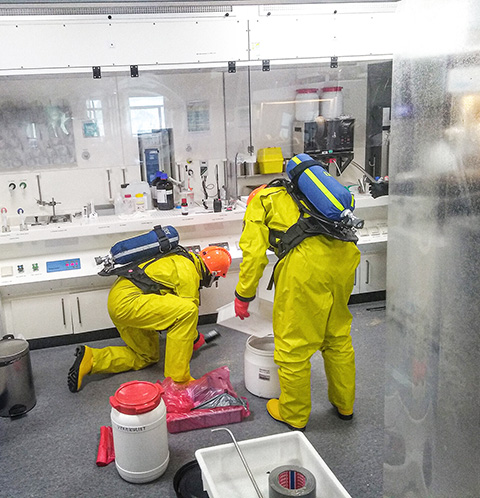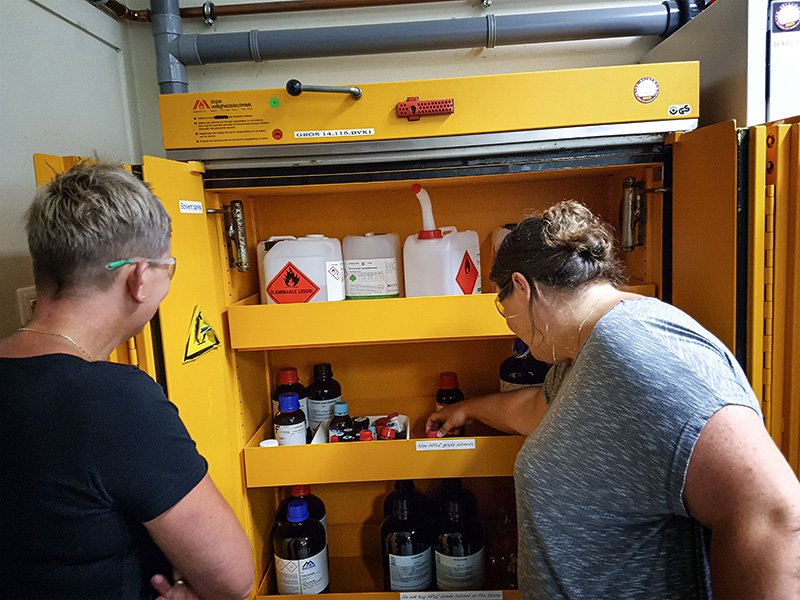
Leaking jars and explosion hazards
Deep cleaning Nijenborgh
Sometimes, the army’s Explosive Ordnance Disposal Service has to be alarmed. When for example a bottle of picric acid, a lemony yellow molecule also known as 2,4,6-trinitrofenol, has fallen dry.
Biologists use it to colour cells. Scientists use it to identify metals and to study their characteristics. However, it must be stored under water, because in dry state, picric acid is hugely explosive – even more so than TNT. And in those cases, a shock (when the bottle falls) or friction (when you screw off the cap whilst crystals are stuck against it) is enough to cause an explosion.
‘With up to 250 gram we handle it ourselves’, head of in-house emergency response Jack Jager of the Faculty of Science and Engineering (FSE) says. ‘But if it’s more, we’re done. Then we call the bomb squad.’
That’s a situation you want to avoid, because in that case the lab needs to be cleared. Sometimes even an entire wing, like in 2018, when during a check, an entire kilo of the substance was found at Nijenborgh 4.
Leakage
Even when there’s no immediate explosion hazard, chemicals that are ‘past their due date’ are a hassle. They could, for example, have corroded the cap of the bottle they’re in. And then it might just happen that a researcher stretches his arm into one of the fireproof cabinets, knocks over a bottle of chloroform and subsequently everything starts leaking through the entire cabinet. Or that the cap breaks when the bottle is lifted, and everything ends up all over the floor.
Then, the in-house emergency service has to step into action. Finding out what it is, how it’s happened. And then, depending on the substance involved, cleaning up the damage. All too often this means: clearing the lab, putting on protective clothes, adding compressed air, oxygen bottle on the back. All in all, it takes them about three to four hours. Not only does this disturb the routine in the lab, it also takes Jager and his colleagues away from their normal work. Thus Jager does not feel all too sorry for the researchers. It’s their own fault,’ he says.
You don’t want to bring that old junk anyway
Because those cabinets, they just have to be tidied up better. FSE safety professionals Theodora Tiemersma and Stijntje Bosman thought the exact same thing. Especially now that the date of the move to the Feringa Building is rapidly approaching – the first groups are already moving next year. And however beautiful and modern the new lab building will be, they’re not getting any more space. ‘You don’t want to bring that old junk anyway,’ says Tiemersma.
Moreover, there are groups that often just casually order a new freezer or a fireproof cabinet, while perhaps it wouldn’t even be necessary if they just clean up their stuff. ‘And then there’s this thing called sustainability, ’ says Tiemersma. ‘Because those freezers, they devour electricity.’

In short: everything that’s older than ten years should really be thrown out. But how do you convince researchers to actually clean up? Because that takes time. Loads of time.
‘You have to sort everything out,’ research assistant Henriette Rozeboom of Groningen Biomolecular Sciences and Biotechnology says. ‘And our lab is located in the oldest part of Nijenborgh, which dates back to 1968. That means that a lot of professors have worked in this lab.’
Tens of years in which professors came and went, leaving their chemicals behind.
Rozeboom estimates that there must be a couple of thousand jars and bottles in her lab which all need to be checked. How old are they? Is the packaging still okay? What is it? You have to do that in parts’, she says. ‘We’re moving in January 2024, so we have to start right about now.’
Campaign
In order to stimulate groups to come and clean out their cabinets, Tiemersma and Bosman started a special campaign: if you clean up the cabinets now, you don’t have to pay the costs for disposal. That bill goes to the faculty board.
Throwing it down the sink is not an option
And the campaign is a success. The lab rooms in wings 16, 17 and 18 at Nijenborgh already seized the opportunity. And so every week, Bosman, FSE’s hazardous materials employee, receives a dozen or so grey boxes of jars with corroded caps and rusty gas bottles. Substances for which she then has to find a carrier with the proper permits. Gases, for example, explosives, or corrosive substances.
That’s not always easy. ‘What’s often difficult here is that you have researchers who finish their PhDs after four years. And then when you do a synthesis, you often save your semi-finished products, so they can continue later, if necessary,’ says Tiemersma.
No label
There’s nothing wrong with that. Except for the fact that those semi-finished products stay in the cabinet, sometimes dissolved in other substances. ‘And then the label’s missing too’, Tiemersma says. ‘You’ll have a bottle with some substance and no idea what it is. You can’t do anything with it.’
They’re like kids with their toys
‘And we absolutely don’t bring a substance like that to the new lab’, Bosman says. ‘But it can’t go back into the cabinet either.’
If they’re lucky, someone in the lab remembers who the jar belongs to and what might possibly be in it. In other cases, a long search begins. ‘Then it’s numerous phone calls and emails and searching to find out where someone went’, Bosman says.
Tiemersma nods. ‘Because throwing it down the sink is not an option. Not ever.’
Clean-up day
She estimates that they’ll still be busy cleaning up for two years, she says. But above all she hopes that after this, it will no longer be necessary. ‘Ideally we’d have something like an annual clean-up day.’
Which might even work, too. Groups now even come to see them of their own accord, Bosman says. ‘We even had one group that had organised a clean-up day on Halloween. They called it HelloClean. And then they did something fun afterwards.’
Moreover, what she sees now is also a relic of another time, Tiemersma says. ‘Department and research leaders are increasingly aware of the importance of safety. In the past, it was often the last item on the list, but that’s changed now.’
Meanwhile, Rozeboom is preparing for the first clean-up day in her lab. And despite the fact that they have to scale down, it might become a hassle. Because of the sheer number of bottles and jars, but also because researchers are often quite attached to their substances. ‘Then they haven’t touched it in years, but when they see it, they don’t want to part from it.’ She smiles. ‘Then they’re like kids with their toys.’